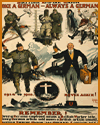Examining maps and pictures can significantly enhance high school World History students' understanding of the rise of dictatorships, totalitarianism, and fascism between the world wars. Visual aids like maps and pictures provide contextual and tangible references that make complex historical events like the rise of fascism more comprehensible and engaging.
Maps are particularly useful in illustrating the geopolitical shifts and territorial changes that occurred after World War I, which created conditions ripe for the rise of dictatorships. For example, maps can show the drastic territorial losses and political fragmentation of countries like Germany and Austria-Hungary due to the Treaty of Versailles. These visual representations help students grasp how these territorial changes fueled national resentment and economic instability, setting the stage for extremist ideologies to gain traction.
Pictures and propaganda posters from the era can provide insights into how totalitarian regimes like those of Hitler, Mussolini, and Stalin used imagery to manipulate public opinion and consolidate power. By analyzing these visual sources, students can understand the role of propaganda in fostering a cult of personality and promoting the regimes' ideologies. Pictures of rallies, military parades, and public events illustrate how mass mobilization and charismatic leadership were crucial in establishing and maintaining control.
Additionally, examining photographs of the socio-economic conditions of the time, such as the Great Depression's impact on everyday life, can help students connect the widespread despair and disillusionment with the appeal of dictatorial promises of stability and revival. Images of poverty, unemployment lines, and political unrest convey the desperation that made totalitarian solutions attractive to many people.
By integrating maps and pictures into their studies, students can develop a more nuanced and vivid understanding of the period between the world wars. These visual tools help bring historical events to life, making it easier for students to comprehend the factors that led to the rise of dictatorships, totalitarianism, and fascism, and their impact on the world.
|











